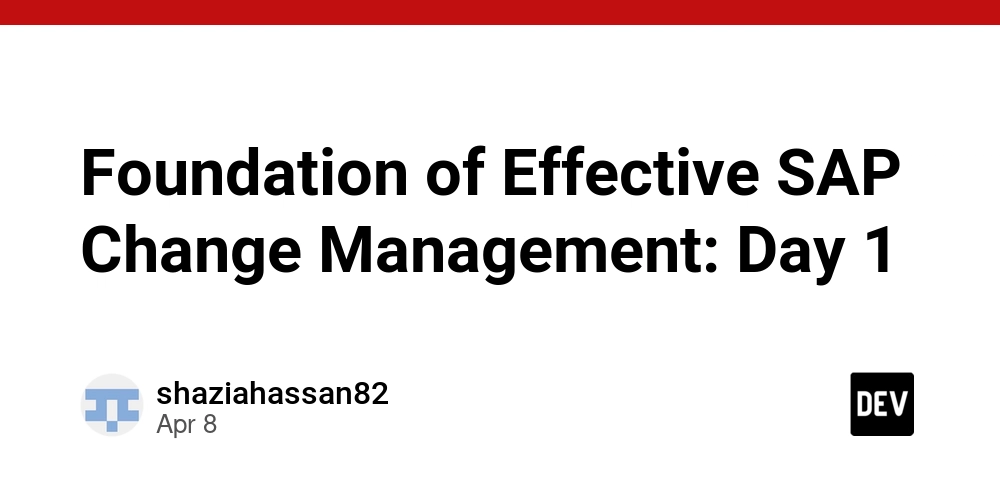Foundation of Effective SAP Change Management: Day 1
For next 7 days, I will be sharing knowledge on SAP Change Management through SAP for defining Product Lifecycle Management workflow for any industry:Below is the quick snapshot which we will be covering in next 7 days Day 1 - Leveraging Change Records Objects Day 2 - Setting up the Change Record Feature in SAP PLM Day 3 - How to Create a Change Records in SAP PLM Day 4 - How to COnfigure Approval Workflows in SAP PLM Day 5 - How to Monitor Worklfow Logs in SAP PLM Day 6 - Best Practices for Workflow Management in SAP PLM Day 7 - Common Roles in an Engineering Change Management Workflow Today, is Day 1, lets dive in to it ... HAPPY LEARNING !!! Day 1 - Leveraging Change Records Objects Introduction Change is inevitable in any business environment, and managing these changes effectively is crucial for maintaining system stability and performance. SAP Change Management provides a structured approach to handle changes in the SAP landscape, ensuring minimal disruption and maximum efficiency. Overview of SAP Change Management SAP Change Management is a comprehensive process that helps organizations manage changes in their SAP systems. It involves planning, testing, and implementing changes in a controlled manner to reduce risks and ensure smooth operations. By following a systematic approach, businesses can ensure that changes are aligned with their strategic goals and do not negatively impact their operations. Detailed Explanation of Change Records Objects SAP Change Management utilizes several key objects to document and track changes. Understanding these objects is essential for effective change management. Change Request (CR): A Change Request is the initial step in the change management process. It is a formal proposal for a change, including details such as the reason for the change, the scope, and the expected impact. The CR is reviewed and approved before any further action is taken. Change Document (CD): Once a Change Request is approved, a Change Document is created. This document contains all the necessary information about the change, including technical details, testing plans, and implementation steps. The CD serves as a comprehensive record of the change and is used to track its progress. Change Task (CT): Change Tasks are specific actions that need to be completed as part of the change. These tasks are assigned to different team members and tracked to ensure timely completion. Each CT is linked to a Change Document, providing a clear view of the tasks required to implement the change. Transport Request (TR): Transport Requests are used to move changes from one SAP system to another. They ensure that changes are consistently applied across all relevant systems. TRs are critical for maintaining system integrity and ensuring that changes are properly tested before being implemented in the production environment. Steps to Implement Change Management in SAP Implementing change management in SAP involves several key steps: Identify the Change: Raise a Change Request (CR) with all necessary details. This includes the reason for the change, the scope, and the expected impact. Approve the Change: Review and approve the Change Request. This step ensures that the proposed change is necessary and aligns with business objectives. Document the Change: Create a Change Document (CD) with detailed information about the change. This includes technical details, testing plans, and implementation steps. Assign Tasks: Break down the change into specific Change Tasks (CT) and assign them to team members. This ensures that all necessary actions are taken to implement the change. Test the Change: Conduct thorough testing to ensure the change works as expected. This step is critical for identifying and addressing any issues before the change is implemented in the production environment. Transport the Change: Use Transport Requests (TR) to move the change to the production environment. This ensures that the change is consistently applied across all relevant systems. Monitor and Review: Monitor the change implementation and review its impact. This step helps identify any issues that may arise and ensures that the change achieves its intended objectives. Best Practices To ensure effective change management, consider the following best practices: • Plan Thoroughly: Ensure all changes are well-planned and documented. This helps prevent misunderstandings and ensures that everyone involved understands the change and its impact. • Test Rigorously: Conduct comprehensive testing to avoid issues in the production environment. This step is critical for identifying and addressing any potential problems before they affect business operations. • Communicate Clearly: Keep all stakeholders informed about the changes and their impact. Clear communication helps ensure that everyone is on the same page and can contribute to the successful implementation of the change. • Monitor Continuously: Continuously monitor changes to identify

For next 7 days, I will be sharing knowledge on SAP Change Management through SAP for defining Product Lifecycle Management workflow for any industry:Below is the quick snapshot which we will be covering in next 7 days
Day 1 - Leveraging Change Records Objects
Day 2 - Setting up the Change Record Feature in SAP PLM
Day 3 - How to Create a Change Records in SAP PLM
Day 4 - How to COnfigure Approval Workflows in SAP PLM
Day 5 - How to Monitor Worklfow Logs in SAP PLM
Day 6 - Best Practices for Workflow Management in SAP PLM
Day 7 - Common Roles in an Engineering Change Management Workflow
Today, is Day 1, lets dive in to it ... HAPPY LEARNING !!!
Day 1 - Leveraging Change Records Objects
Introduction
Change is inevitable in any business environment, and managing these changes effectively is crucial for maintaining system stability and performance. SAP Change Management provides a structured approach to handle changes in the SAP landscape, ensuring minimal disruption and maximum efficiency.
Overview of SAP Change Management
SAP Change Management is a comprehensive process that helps organizations manage changes in their SAP systems. It involves planning, testing, and implementing changes in a controlled manner to reduce risks and ensure smooth operations. By following a systematic approach, businesses can ensure that changes are aligned with their strategic goals and do not negatively impact their operations.
Detailed Explanation of Change Records Objects
SAP Change Management utilizes several key objects to document and track changes. Understanding these objects is essential for effective change management.
Change Request (CR):
A Change Request is the initial step in the change management process. It is a formal proposal for a change, including details such as the reason for the change, the scope, and the expected impact. The CR is reviewed and approved before any further action is taken.
Change Document (CD):
Once a Change Request is approved, a Change Document is created. This document contains all the necessary information about the change, including technical details, testing plans, and implementation steps. The CD serves as a comprehensive record of the change and is used to track its progress.
Change Task (CT):
Change Tasks are specific actions that need to be completed as part of the change. These tasks are assigned to different team members and tracked to ensure timely completion. Each CT is linked to a Change Document, providing a clear view of the tasks required to implement the change.
Transport Request (TR):
Transport Requests are used to move changes from one SAP system to another. They ensure that changes are consistently applied across all relevant systems. TRs are critical for maintaining system integrity and ensuring that changes are properly tested before being implemented in the production environment.
Steps to Implement Change Management in SAP
Implementing change management in SAP involves several key steps:
- Identify the Change: Raise a Change Request (CR) with all necessary details. This includes the reason for the change, the scope, and the expected impact.
- Approve the Change: Review and approve the Change Request. This step ensures that the proposed change is necessary and aligns with business objectives.
- Document the Change: Create a Change Document (CD) with detailed information about the change. This includes technical details, testing plans, and implementation steps.
- Assign Tasks: Break down the change into specific Change Tasks (CT) and assign them to team members. This ensures that all necessary actions are taken to implement the change.
- Test the Change: Conduct thorough testing to ensure the change works as expected. This step is critical for identifying and addressing any issues before the change is implemented in the production environment.
- Transport the Change: Use Transport Requests (TR) to move the change to the production environment. This ensures that the change is consistently applied across all relevant systems.
- Monitor and Review: Monitor the change implementation and review its impact. This step helps identify any issues that may arise and ensures that the change achieves its intended objectives. Best Practices To ensure effective change management, consider the following best practices: • Plan Thoroughly: Ensure all changes are well-planned and documented. This helps prevent misunderstandings and ensures that everyone involved understands the change and its impact. • Test Rigorously: Conduct comprehensive testing to avoid issues in the production environment. This step is critical for identifying and addressing any potential problems before they affect business operations. • Communicate Clearly: Keep all stakeholders informed about the changes and their impact. Clear communication helps ensure that everyone is on the same page and can contribute to the successful implementation of the change. • Monitor Continuously: Continuously monitor changes to identify and address any issues promptly. This helps ensure that changes achieve their intended objectives and do not negatively impact business operations.
Conclusion
Effective change management is essential for maintaining the stability and performance of SAP systems. By following a structured approach and leveraging Change Records objects, organizations can manage changes efficiently and minimize risks. Implementing best practices and continuously monitoring changes can help ensure that changes are successfully integrated into the SAP environment, supporting business objectives and maintaining system integrity.











































































































































































![[The AI Show Episode 143]: ChatGPT Revenue Surge, New AGI Timelines, Amazon’s AI Agent, Claude for Education, Model Context Protocol & LLMs Pass the Turing Test](https://www.marketingaiinstitute.com/hubfs/ep%20143%20cover.png)






































































































































































































































.png?#)


































.webp?#)
.webp?#)

.webp?#)


























































































![[Fixed] Gemini app is failing to generate Audio Overviews](https://i0.wp.com/9to5google.com/wp-content/uploads/sites/4/2025/03/Gemini-Audio-Overview-cover.jpg?resize=1200%2C628&quality=82&strip=all&ssl=1)

![What’s new in Android’s April 2025 Google System Updates [U: 4/14]](https://i0.wp.com/9to5google.com/wp-content/uploads/sites/4/2025/01/google-play-services-3.jpg?resize=1200%2C628&quality=82&strip=all&ssl=1)













![Apple Seeds tvOS 18.5 Beta 2 to Developers [Download]](https://www.iclarified.com/images/news/97011/97011/97011-640.jpg)
![Apple Releases macOS Sequoia 15.5 Beta 2 to Developers [Download]](https://www.iclarified.com/images/news/97014/97014/97014-640.jpg)


































































































































